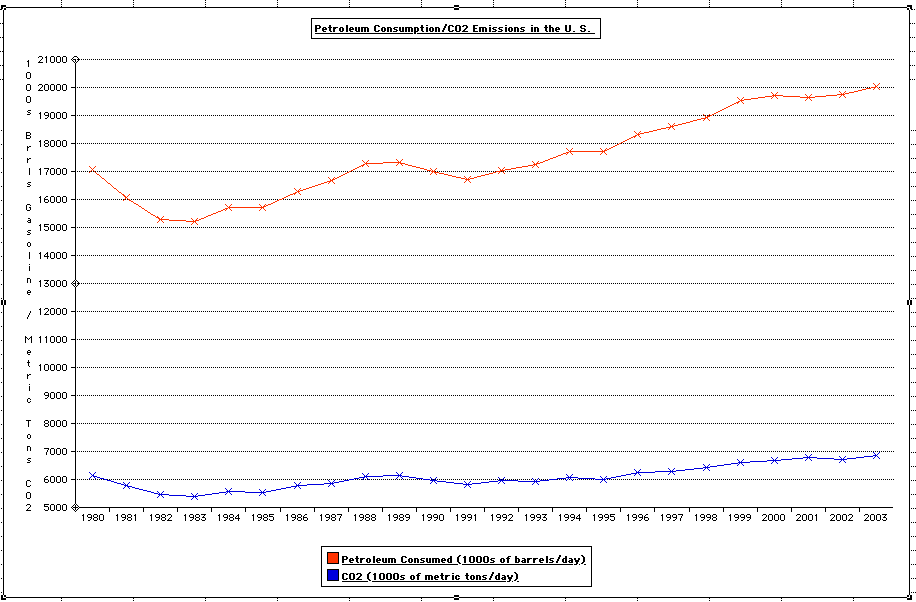Driving your car, air-conditioning your home, eating, traveling by commercial air and recycling all affect the amount of CO2 released into our atmosphere.
Take The Carbon Quiz to see what your CO2 contirbution is. Then, if your concerned, visit one of these sites if you’d like to find out how to offset your CO2 impact on our only home.
From the Energy Information Administration:
Carbon Dioxide Emissions from the Consumption and Flaring of Fossil Fuels
Total world carbon dioxide emissions from the consumption of petroleum, natural gas, and coal, and the flaring of natural gas increased from 21.5 billion metric tons of carbon dioxide in 1993 to 25.2 billion metric tons in 2003, or by 17.1 percent. The average annual growth rate of carbon dioxide emissions over the period was 1.6 percent (Note: Carbon dioxide emissions are measured here in metric tons of carbon dioxide. Tons of carbon dioxide can be converted to tons of carbon equivalent by multiplying by 12/44. ) The United States, China, Russia, Japan, and India were the world’s five largest sources of carbon dioxide emissions from the consumption and flaring of fossil fuels in 2003, producing 52 percent of the world total. The next five leading producers of carbon dioxide emissions from the consumption and flaring of fossil fuels were Germany, Canada, the United Kingdom, South Korea, and Italy, and together they produced an additional 12 percent of the world total. In 2003, total United States carbon dioxide emissions from the consumption and flaring of fossil fuels were 5.8 billion metric tons of carbon dioxide, more tha one and one-half times as much as the 3.5 million metric tons produced by China, while Russia produced 1.6 billion metric tons.
In 2003, the consumption of petroleum was the world’s primary source of carbon dioxide emissions from the consumption and flaring of fossil fuels, accounting for 42 percent of the total. Between 1993 and 2003 emissions from the consumption of petroleum increased by 1.4 billion metric tons of carbon dioxide, or 15.4 percent, rising from 9.1 to 10.5 billion metric tons. The United States was the largest producer of carbon dioxide from the consumption of petroleum in 2003 and accounted for 24 percent of the world total. China was the second largest producer, followed by Japan, Russia, and Germany, and together these four countries accounted for an additional 20 percent.
Coal ranked second as a source of carbon dioxide emissions from the consumption and flaring of fossil fuels in 2003, accounting for 37 percent of the total. World carbon dioxide emissions from the consumption of coal totaled 9.3 billion metric tons of carbon dioxide in 2003, up 16.3 percent from the 1993 level of 8.0 billion metric tons. China and the United States were the two largest producers of carbon dioxide from the consumption of coal in 2003 and together they accounted for 52 percent of the world total. India, Russia, and Japan accounted for an additional 16 percent.
Carbon dioxide emissions from the consumption and flaring of natural gas accounted for the remaining 21 percent of carbon dioxide emissions from the consumption and flaring of fossil fuels in 2003. Emissions from the consumption and flaring of natural gas increased from 4.4 billion metric tons of carbon dioxide in 1993 to 5.3 billion metric tons in 2003, or by 22.2 percent. The United States and Russia were the two largest producers of carbon dioxide from the consumption and flaring of natural gas in 2003 and together they accounted for 38 percent of the world total. The United Kingdom, Canada, and Germany accounted for an additional 10 percent.
The chart below is based on petroleum consumption and and CO2 emissions data from the Energy Information Administration, Official Energy Statistics from the U.S. Government
U.S. CO2 Emissions Growth Slower than Petroleum Consumption Growth.

Click on image for full view.





























